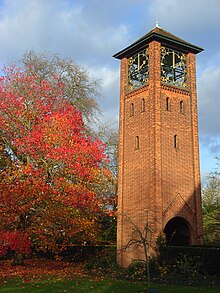University of Reading War Memorial
 From Wikipedia - Reading time: 7 min
From Wikipedia - Reading time: 7 min
| University of Reading War Memorial | |
|---|---|
| United Kingdom | |
 | |
| For approximately 200 men and women from Reading killed in war | |
| Unveiled | 1924 |
| Location | 51°27′01.6″N 00°57′40.3″W / 51.450444°N 0.961194°W |
| Designed by | Herbert Maryon |
Listed Building – Grade II | |
| Official name | University of Reading War Memorial |
| Designated | 12 February 1987 |
| Reference no. | 1113620 |
The University of Reading War Memorial is a clock tower, designed by Herbert Maryon and situated on the London Road Campus of the University of Reading. Initially designed as a First World War memorial and dedicated in June 1924, it was later expanded in scope to also serve as a memorial of later wars.
History and design
[edit]Memorials to servicemen who died in the First World War were erected soon after the end of the conflict.[1] Plans to build a permanent memorial at the University of Reading unfolded in 1919, when William Macbride Childs, the principal of the college, printed a pamphlet suggesting several ideas.[2] The final design was ultimately made by Herbert Maryon, a teacher of sculpture at the university;[2] he would later gain broad recognition in a second career at the British Museum, where he conserved many of the finds from the Sutton Hoo ship-burial, termed "the most important single discovery in British archaeology."[3] His initial proposal, made in 1919, was for a tower of 120 feet (37 m) that would have cost between £5,000 and £10,000.[1] The funds could not be raised, and in 1923 Maryon proposed a structure of half that height.[1][2] Construction began that November, and the memorial was dedicated the following June.[2] The finished memorial, which cost £2,750, is a 60-foot-tall (18 m) brick tower with a clock, a bell, and a bronze roll of honour listing the names of more than 140 people who died in the war.[2][4]
The scope of the memorial was expanded following the Second World War, and in May 1953 a panel with more than 70 names of the dead from that conflict was unveiled.[1][2][4][5] It now also commemorates those who died in the war in Afghanistan;[2] in 2012 a plaque was unveiled honouring Lieutenant Colonel Rupert Thorneloe, MBE, a 1991 graduate of the University whose 2009 death made him the highest-ranking officer of the British Army killed in action since the Falklands War.[6]
On 12 February 1987, the memorial was designated a grade II listed building, a status given for its special architectural or historic interest.[7]
On 9 November 2018, the University of Reading announced plans to add nine additional names of servicemen who died in the First World War to the memorial.[8][9][10]
References
[edit]- ^ a b c d "War and Memory". University of Reading. 2016. Archived from the original on 16 October 2018. Retrieved 15 October 2018.

- ^ a b c d e f g "Reading University College: WW1 and Beyond". University of Reading. 2014. Archived from the original on 16 October 2018. Retrieved 15 October 2018.

- ^ Bruce-Mitford, Rupert (23 July 1965). "Mr. Herbert Maryon". Obituary. The Times. No. 56381. London. p. 14.
- ^ a b "Reading University". War Memorials Register. Imperial War Museums. Archived from the original on 9 October 2018. Retrieved 9 October 2018.

- ^ "Photograph from Reading Chronicle Collection - May 1953". Reading Museum. 6 July 2012. Archived from the original on 1 July 2022. Retrieved 29 January 2020.

- ^ "British Army Officer Killed in Afghanistan Honoured by University of Reading". University of Reading. 6 July 2012. Archived from the original on 29 November 2018. Retrieved 15 October 2018.

- ^ "University of Reading War Memorial". Historic England. Archived from the original on 11 October 2018. Retrieved 11 October 2018.

- ^ Baxter, Guy (2 November 2018). "Not forgotten: University of Reading to add names to war memorial". University of Reading Special Collections. University of Reading. Archived from the original on 25 December 2019. Retrieved 25 December 2019.

- ^ "University of Reading". University of Reading. Archived from the original on 30 November 2018. Retrieved 30 November 2018.

- ^ "University of Reading to Add Names To War Memorial". Reading.co.uk. 9 November 2018. Archived from the original on 30 November 2018. Retrieved 30 November 2018.

 KSF
KSF